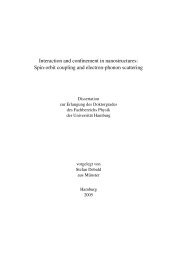Measuring the Electron Beam Energy in a Magnetic Bunch ... - DESY
Measuring the Electron Beam Energy in a Magnetic Bunch ... - DESY
Measuring the Electron Beam Energy in a Magnetic Bunch ... - DESY
You also want an ePaper? Increase the reach of your titles
YUMPU automatically turns print PDFs into web optimized ePapers that Google loves.
not possible to disentangle which energy change was caused by <strong>in</strong>com<strong>in</strong>g arrival-time<br />
jitter and which energy change was caused by accelerat<strong>in</strong>g gradient and phase jitter<br />
unless <strong>the</strong> arrival-time jitter generated upstream of <strong>the</strong> accelerator section has been<br />
measured.<br />
There are two different strategies to deal with this problem. One could use an<br />
accelerator section upstream of each chicane <strong>in</strong> order to stabilize <strong>the</strong> arrival-time after<br />
each chicane, regardless of how much <strong>the</strong> beam energy jitter is <strong>in</strong>creased. One would<br />
<strong>the</strong>n need to stabilize <strong>the</strong> beam energy us<strong>in</strong>g an accelerator section located after <strong>the</strong><br />
chicanes. Alternatively, one could use a s<strong>in</strong>gle accelerator section gradient setpo<strong>in</strong>t to<br />
simultaneously stabilize <strong>the</strong> beam energy and arrival-time after each chicane. The endresult<br />
of both schemes would, <strong>in</strong> pr<strong>in</strong>ciple, be <strong>the</strong> same.<br />
For <strong>the</strong> sake of mach<strong>in</strong>e stability, <strong>the</strong> author believes that <strong>the</strong> latter option is<br />
better: a feedback on <strong>the</strong> first accelerator section should not respond to changes <strong>in</strong> <strong>the</strong><br />
<strong>in</strong>jector jitter and a feedback on <strong>the</strong> second accelerator section should not respond to<br />
changes <strong>in</strong> <strong>the</strong> first accelerator section. To simultaneously stabilize beam energy and<br />
arrival-time after a bunch compressor, one could execute a comb<strong>in</strong>ation of <strong>the</strong> follow<strong>in</strong>g:<br />
• use measurements of <strong>the</strong> arrival-time jitter upstream of a bunch compressor to<br />
keep <strong>the</strong> energy/arrival-time feedback from respond<strong>in</strong>g to <strong>the</strong> energy/arrival-time<br />
jitter that it creates.<br />
• stabilize <strong>the</strong> arrival-time jitter upstream of <strong>the</strong> bunch compressor before<br />
correct<strong>in</strong>g <strong>the</strong> energy/arrival-time jitter downstream.<br />
3.3 <strong>Beam</strong>-Based Feedback Strategy<br />
Two schematics of <strong>the</strong> synchronization sensitive components <strong>in</strong> <strong>the</strong> mach<strong>in</strong>e are<br />
shown <strong>in</strong> Fig. 3.3.1 [27]. An optimal feedback setup is depicted <strong>in</strong> Fig. 3.3.1(a.) and a<br />
more quickly realizable architecture is depicted <strong>in</strong> Fig. 3.3.1(b.). The <strong>in</strong>jector laser<br />
(Laser), <strong>the</strong> <strong>in</strong>jector RF (Gun), <strong>the</strong> super-conduct<strong>in</strong>g accelerator sections (ACC1-7) and<br />
<strong>the</strong> third-harmonic module (third-) are depicted <strong>in</strong> block diagram format with arrows<br />
connect<strong>in</strong>g various optical cross-correlators (OCC), chicane beam position monitors<br />
(EBPM), bunch length monitors (EO-1D, THz-1D), and beam arrival-time monitors<br />
(BAM) to <strong>the</strong> digital process<strong>in</strong>g boards (μTCA or SIMCON-DSP) with which <strong>the</strong>y<br />
would be connected <strong>in</strong> a beam-based feedback system that controls, on a bunch-to-bunch<br />
basis, <strong>the</strong> amplitude and phase (A, φ) of a normal-conduct<strong>in</strong>g RF cavity (3GHz NRF<br />
cavity), <strong>the</strong> 1.3 GHz super conduct<strong>in</strong>g acceleration cavities (1.3GHz SRF ACC1(2&3))<br />
and <strong>the</strong> super conduct<strong>in</strong>g third- harmonic l<strong>in</strong>earization cavity (3.9GHz SRF).<br />
The reason that <strong>the</strong> system shown <strong>in</strong> Fig 3.3.1(b.) will be built before that shown<br />
<strong>in</strong> Fig 3.3.1(a.) is that <strong>the</strong> μTCA crate system, shown <strong>in</strong> blue <strong>in</strong> <strong>the</strong> figures below, along<br />
with <strong>the</strong> correspond<strong>in</strong>g ADC and FPGA boards will not be available <strong>in</strong> 2010. VME is <strong>the</strong><br />
crate system that has been used at FLASH s<strong>in</strong>ce its <strong>in</strong>ception but will be phased out as<br />
μTCA crates become viable. In <strong>the</strong> currently available VME crate <strong>in</strong>frastructure, <strong>the</strong><br />
beam arrival-time is calculated on an <strong>in</strong>-house built Analog Carrier Board (labeled ACB<br />
<strong>in</strong> <strong>the</strong> figure) that conta<strong>in</strong>s ADCs, delay-chips and FPGAs. <strong>Beam</strong> arrival-time<br />
<strong>in</strong>formation from this board is delivered to <strong>the</strong> cavity controller via an optical Gigal<strong>in</strong>k.<br />
The cavity controllers reside on VME based SIMCON-DSP boards that each have ADCs,<br />
DSPs, DACs, and an FPGA.<br />
28

















